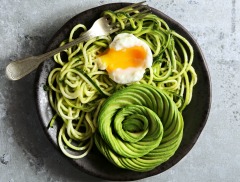Don't just meal plan... meal plan intelligently - with Meal Genius! Sign up for our free newsletter to get delicious recipes, sample meal plans and a whole lot more!
Ostrich
Ostrich is becoming more and more popular across the U.S., with meat that can be compared in flavor and texture to very lean beef.
Ostrich comes in a variety of cuts, including prime steaks, filets, sausages, burgers, and diced. It can be substituted for beef, pork, lamb, turkey, or chicken in virtually any recipe.
Due to its low fat content, ostrich cooks faster than other meats. Steaks should be cooked medium rare to medium.
With more protein and less fat and calories than its feathered cousins, ostrich is an excellent source of iron, zinc, selenium, vitamin B6, vitamin B12 and niacin.
The Benefits
- Special diets: Autoimmune Paleo Diet, Candida Diet, Diabetic, Elimination Diet, Gluten-Free Diet, Gluten-Free/Dairy-Free Diet, Grain-Free Diet, High Protein Diet, Low Acid Diet, Low Carb Diet, Low FODMAP Diet, Low Histamine Diet, Low Oxalate Diet, Low Starch Diet, Paleo Diet (Light), Paleo Diet (Strict), PCOS Diet, Primal Diet, Thyroid Diet, Whole Food
- Excellent Source of: Iron, Protein, Selenium, Zinc, VitaminB6, VitaminB12, Niacin
- Good Source of: Thiamin, Riboflavin, Phosphorous
- Preferences: No Molds, No Pseudograins, No Coconut, No Corn, No Yeast, No Peanuts, No Citrus, No Fish, No Red Meat, No Pork, No Eggs, No Shellfish, No Gluten, No Nuts, No Seeds, No Soy, No Dairy, No Nightshade, No Legumes, No Grains, Low Carbohydrate, Low Fat, Low Sodium, Low Sugars, Low Saturated Fat
Related Foods
Related Nutrients
Selecting and Storing
Ostrich meat is still quite rare, and can be found at specialty markets, ostrich ranches and some restaurants.









